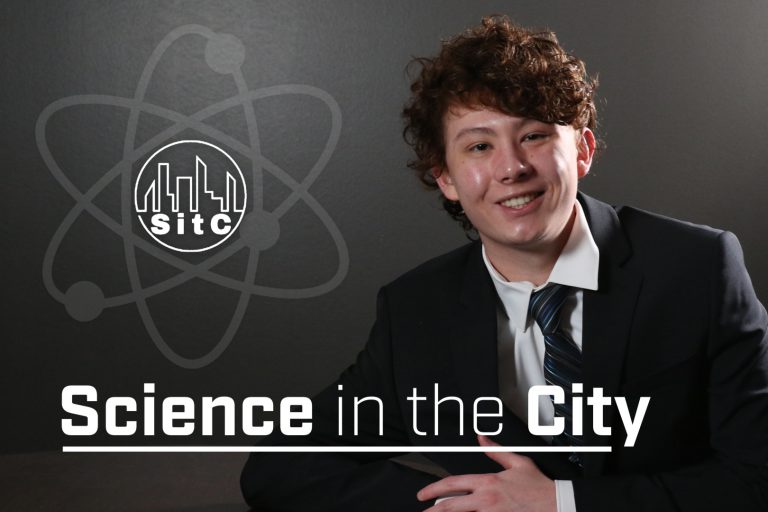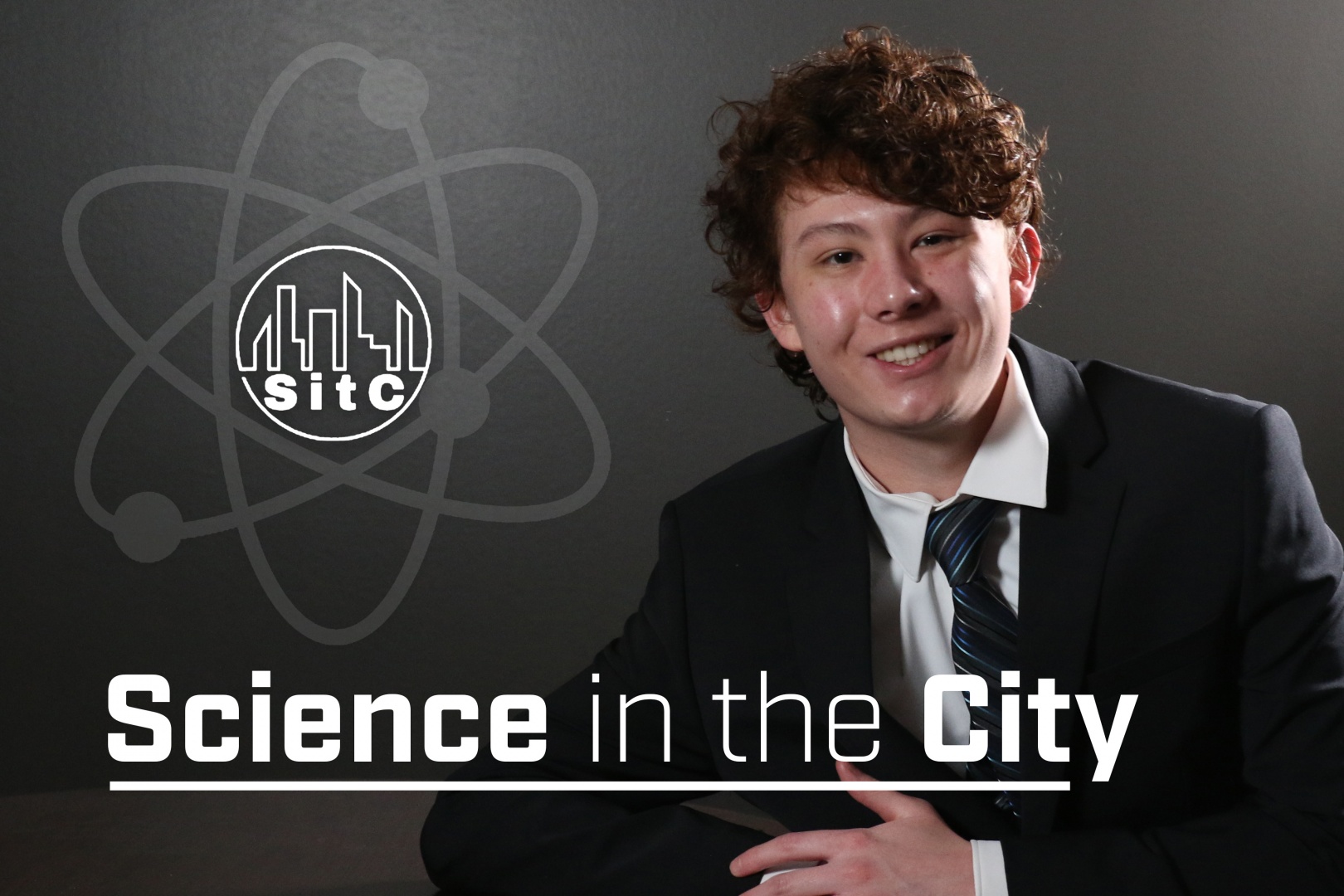

Science in the City

Ever sit in a science or math class when you were in school and wonder, either quietly or out loud, when will I ever use this? Davis Verhoeven, a senior at Ames High School, aims to showcase exactly how science, math, engineering, and technology (STEM) are used every day and in almost every career through a self-founded after-school program called, Science in the City.
Science in the City (SitC) is designed to raise awareness about how STEM is inherent in every career and business venture. This program partners middle school student teams with a high school mentor and a local business. Teams are challenged to collaborate with their partner business in order to explore how it uses STEM on a day-to-day basis. Using that knowledge, teams build hands-on demonstrations to showcase this use of STEM and present their findings at a final Science in the City public event.
“Science in the City actually evolved from my brother working on his science homework,” said Verhoeven. “It was a worksheet and it turned him off to science instantly. That sparked an idea and turned into an answer to the question, how can students be engaged in all of the STEM that goes on in our community?”
Building on this idea and giving it a practical application was of top importance to Verhoeven. From there, SitC developed and was presented to the School Board on February 24, 2020. In fact, recruitment of middle-schoolers and high school mentors was just about to begin the following week and then, the global pandemic brought everything to a stop. The program shut down, leaving Verhoeven to wait another year before starting this venture.
“It’s been interesting to see how the program has evolved in light of COVID,” Verhoeven said. “While we can’t do some of the in-person items this year, we can do a lot of cool new things by going online.”
One of Verhoeven’s goals was to broaden the participation of underrepresented minorities in the STEM discipline. While SitC had a strong focus on equity from the beginning, this evolved further by going virtual. All that was needed to take part was an internet connection, opening the possibility to any student who wanted to participate.
“We have demographics in this group from low socioeconomic status, alternative learning program, extended learning program, special education, and students who haven’t yet found out where their interest lies in STEM development,” said Katrina Williams, middle school advisor for SitC. “When you have that breadth of student interest, it warms my heart that we are on the right path.”
Not only is SitC getting involvement from a diverse group of students, but also those who normally wouldn’t have garnered any interest whatsoever. One such student is Isabel Conner, an 8th grader at Ames Middle School.
“My level of interest in STEM wasn’t very high,” said Conner, “but this sounded interesting and I wanted to know more about STEM and how it can be fun.”
Creatively cultivating interest in STEM was another of Verhoeven’s goals. He hopes to accomplish this by showcasing the everyday application through local businesses, rather than reading about it in a textbook. Through this creative application, he hopes to curb what he calls STEM blindness. STEM blindness is “when people look at science, technology, engineering, and math careers as very specific,” according to Verhoeven. For example, scientists in a lab or doctors in a hospital. This thinking leads to believing that STEM simply doesn’t apply at an individual level unless there is a strong interest in one of those areas.
“Society as a whole doesn’t engage in STEM,” adds Verhoeven. “So people believe it’s something you use if you are a scientist or in class and that’s just incorrect. We all use it.”
SitC currently has involvement from over 40 middle school students, 7 high school mentors, and approximately 10 local businesses. Students spent much of April meeting with their assigned business to learn how they use STEM daily. One such business is Salon Bonita, where Verhoeven states even the stylist had no idea she was using science on a daily basis.
“While a hairdresser may be considering how to cut a person’s hair because of the different structure,” he says, “they are not thinking this is biology because they didn’t read about it in a textbook.”
The involvement from local businesses checked off another important goal for Verhoeven. What he saw lacking in his brother’s worksheet homework assignment was engagement. He sees businesses engaging with the community as much if not more than students, so it seemed like a perfect collaboration. Taking a deeper dive into how businesses use STEM has been rewarding for Verhoeven. That encouragement comes from students and business owners alike and has been eye opening to all. Conner’s group is working with Blue Sky Orthodontics, where her group is seeing first-hand how STEM works not only in everyday life, but also in business.
“We learned how they make Invisalign,” said Conner when asked about the coolest thing she’d learned so far. “You have to make a model of each tray and then make the aligners. It’s not something I’d thought about and it’s not just science.”
Williams notes, from a teacher perspective, she hopes seeing STEM at work on a daily basis cultivates into a lifestyle and students see it truly is used in any career.
“Textbook science and exploratory science are two different things,” says Williams. “Not all students are apt to open a textbook and do problems but are more likely to do a practical application. This shows that STEM is invigorating and it’s fun.”
The entire SitC program wraps up with a concluding event in May where not only the businesses are showcased, but students are able to share what they learned to the entire Ames community. While details of moving the event to a virtual nature are still being solidified, Verhoeven says the event, as a whole, checks off one more goal, teaching what he calls 21st century skills. These essential skills include interviewing, sending professional emails, public speaking, presentation skills, working with a team, and being a leader.
“There are so many skills it teaches that are amazingly useful regardless of where (students) want to go and what they want to do,” adds Verhoeven. “It helps in any career they wish to pursue.”
Verhoeven’s efforts have not gone unnoticed. The group’s high school leadership was asked to present to teachers across the state for the Iowa Academy of Science’s Iowa Science Teaching Section (ISTS) virtual spring conference in March. Here they spoke about the SitC program and how it could be implemented in schools throughout Iowa. They also received a Governor’s STEM BEST (Businesses Engaging Students and Teachers) partnership award. According to their website, the STEM BEST Program focuses on teachers and industry professionals working side-by-side to craft curriculum and projects that prepare students for exciting STEM careers local to their community in manufacturing, information technology, bioscience (agriculture and medicine), finance, and more.
“Students are really the driving force,” says Williams, who has much pride for the program and its efforts in its first year.
After spending nearly two years developing a program that delivers on a creative, practical application of STEM coupled with community engagement, and draws a diverse group of learners who gain 21st century skills, what is next for Verhoeven? He is training for leadership succession at the high school so SitC can continue on, even after he graduates. Then, he plans to attend college and major in possibly biology with a particular interest in bioengineering, even perhaps teaching in higher education someday.
“I want to continue to make an impact on my community and have the ability to teach others and give back,” said Verhoeven. “That’s important to me.”